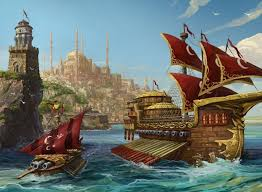Empire’s naval dominance, at the height of its power, was not just a land-based superpower; it commanded the waves with a naval force that struck fear into its adversaries. But how did a dynasty that began in the Anatolian heartland grow into a maritime juggernaut? Let’s set sail through the rich history of the Ottoman navy and uncover the secrets behind its dominance.
The Birth of Ottoman Naval Power

Foundations in Anatolia
The Ottomans, starting as a small frontier principality, quickly realized the importance of controlling waterways. Their early conquests along the Aegean and Marmara coasts laid the groundwork for their maritime ambitions.
Seizing Constantinople
When Sultan Mehmed II conquered Constantinople in 1453, the Ottomans gained control of the Bosphorus Strait. This strategic waterway connected the Black Sea to the Mediterranean, becoming a vital artery for trade and military movements.
The Rise of a Maritime Empire
Establishing Shipyards
To dominate the seas, you need ships lots of them. The Ottomans built shipyards, like the one in Galata, which became hubs of naval innovation and production.
The Role of Güleddin Barbarossa
One cannot discuss Ottoman naval power without mentioning the legendary admiral, Hayreddin Barbarossa. His daring exploits in the Mediterranean during the 16th century made the Ottomans a formidable maritime force.
Solar Power for Your Home: MUST-READ Before You Take the Plunge
Key Battles and Campaigns
Battle of Preveza (1538)
This monumental battle solidified Ottoman control over the eastern Mediterranean. Facing the Holy League’s fleet, Barbarossa’s strategic brilliance secured a decisive victory.
Siege of Rhodes (1522)
The conquest of Rhodes brought the Ottomans face-to-face with the Knights of St. John. Despite fierce resistance, Ottoman forces triumphed, further expanding their influence.
The Long War Against Venice
For centuries, Venice and the Ottoman Empire vied for control of trade routes and territories. The Ottoman navy’s successes, such as the conquest of Cyprus in 1571, were critical in these conflicts.
Innovations and Strategy
Technological Advancements
The Ottomans were quick to adopt new technologies, such as advanced cannons and galleys. Their ships were not only fast but also heavily armed.
Naval Organization
The Ottoman navy was meticulously organized, with clear hierarchies and specialized roles. This structure ensured efficiency and effectiveness in their operations.
Coastal Fortifications
To secure their maritime dominance, the Ottomans built robust fortifications along key coastal cities, like Algiers and Tripoli, turning them into impregnable naval bases.
The Decline of Ottoman Naval Power
Challenges in the 17th Century
As European powers like Spain and Portugal expanded their navies, the Ottomans faced increased competition. Their defeat at the Battle of Lepanto in 1571 marked a turning point.
Internal Struggles
Political instability and corruption within the empire weakened its naval capabilities. Resources were often mismanaged, leading to a decline in fleet quality.
Legacy and Influence
Maritime Law and Trade
The Ottoman Empire’s control of key waterways influenced maritime law and trade routes for centuries. Their policies set precedents for controlling strategic chokepoints.
Cultural Impact
The Ottoman navy left a lasting legacy in art, literature, and architecture. Naval victories and maritime themes were celebrated in Ottoman miniatures and poetry.
Lessons from History
Adaptability is Key
The Ottomans’ ability to adapt to new technologies and strategies was a cornerstone of their naval success.
The Importance of Visionary Leaders
Figures like Barbarossa demonstrate how visionary leadership can transform a navy from a regional force into a global powerhouse.
Modern Reflections
Geopolitical Significance
The Ottoman Empire’s maritime history offers valuable lessons for modern geopolitics, particularly in the importance of controlling strategic waterways.
Naval Traditions Today
Turkey, as a successor state of the Ottoman Empire, continues to maintain a strong naval presence, reflecting its historical maritime heritage.
Conclusion
The Ottoman Empire’s naval dominance was a blend of strategic foresight, technological innovation, and bold leadership. Their story reminds us of the profound impact a well-organized navy can have on the course of history. So, the next time you hear the waves crashing on a distant shore, think of the Ottoman galleys that once ruled the seas.
The Anti-Apartheid Movement in South Africa: A Fight for Freedom and Justice
FAQs
What made the Ottoman navy so powerful?
The combination of strategic locations, advanced shipbuilding techniques, and visionary leaders like Barbarossa made the Ottoman navy formidable.
What was the significance of the Battle of Preveza?
The Battle of Preveza in 1538 solidified Ottoman dominance in the Mediterranean and showcased their naval prowess against European powers.
How did the Ottoman navy decline?
The rise of European naval powers, internal corruption, and technological stagnation contributed to the decline of the Ottoman navy.
What role did trade play in Ottoman naval dominance?
Control of key trade routes, such as the Bosphorus Strait, allowed the Ottomans to dominate regional commerce and finance their naval campaigns.
How does Turkey reflect its Ottoman naval heritage today?
Turkey maintains a strong naval presence and honors its Ottoman maritime history through naval traditions and ceremonies.
Meta Description: Discover the rise and fall of the Ottoman Empire’s naval dominance. Explore key battles, leaders, and lessons that shaped maritime history.


